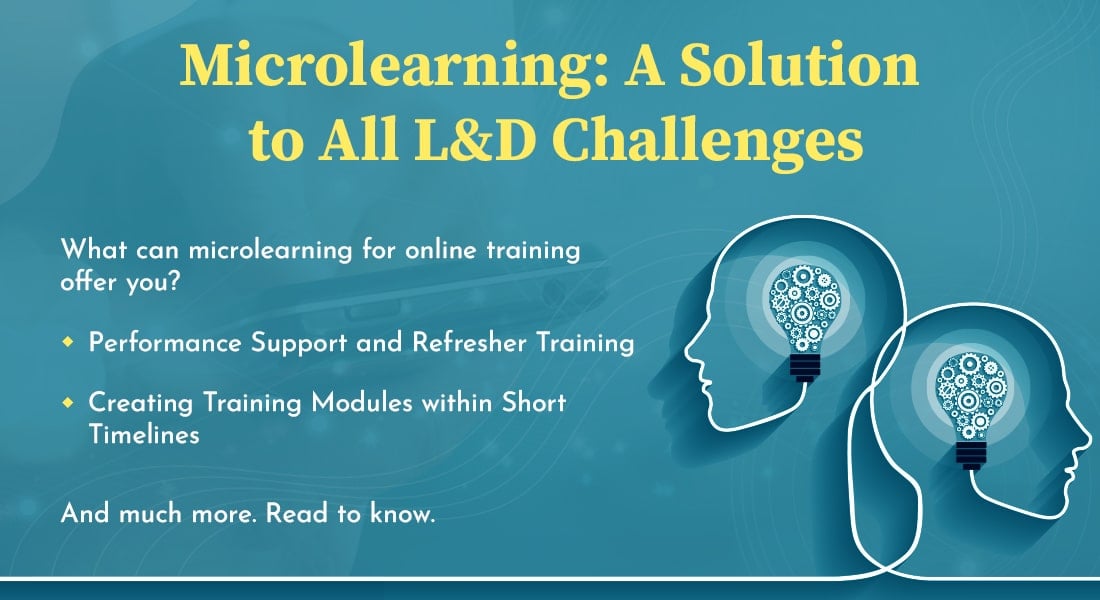Solve These 5 Online Training Woes with Microlearning

Everything seems to be shrinking nowadays. Those hour-long PPT driven, red and black scribbled white boards have shrunk to something we now refer to as microlearning. And as far as online corporate training goes, microlearning for online training has become a bestseller.
Microlearning for Online Training Solves 5 L&D Hurdles
Use Microlearning to:
- Combat the Forgetting Curve
- Offer Refresher and Performance Support Solutions
- Train Employees Effectively within Timelines
- Support Just-in-Time and Self-Paced Learning
- Improve Performance and Organizational ROI
Microlearning is made up of bite-sized learning modules, provided to learners over the learning management system as digital resources. Each microlearning module deals with a single performance-driven learning objective, making them highly compact and focussed. The duration of each module is usually no more than fifteen minutes, making it the perfect solution to check pre-training recall as well as to offer post-training performance support.
This blog discusses microlearning for online training as a solution to L&D problems. I present to you – five microlearning solutions for L&D issues. Shall we proceed?
This free webinar discusses the complete implementation roadmap for microlearning. Watch Here!
Five Corporate Training Issues Addressed by Microlearning
What follows is how microlearning as an L&D solution helps overcome issues faced by corporate training in a remote setting.
1. Counters the Forgetting Curve
One of the biggest issues of corporate training is learners forgetting what they have learned much sooner than expected. There being no tangible way to calculate how much learners have retained after a single course or module other than good old assessments. Microlearning which ensures that learners remember most of the information, comes in like a boon.
German psychologist Herman Ebbinghaus postulated that learners forget most of what they have learned in less than a day, retaining only around 20% by the end of the week. He called it the forgetting curve that as you can imagine, takes a lot away from the effectiveness of training.
Microlearning modules are highly focussed, dealing with a single performance driven learning objective. What that means is that a custom eLearning course or VILT session dealing with multiple learning objectives can be broken down into several bite-sized 10–15-minute microlearning modules. And because these micromodules are so short and deal with only one objective, learning becomes more memorable and the information is better retained.
2. Offers Solutions for Refresher Training and Performance Support
Learning is a continuous process and so formal training needs to be followed by refresher training and performance support to be effective. Making learners go through the same training at regular intervals as refresher training would bore them to bits, defeating the very purpose of refresher training. But thanks to microlearning, learners do not need to go through the same materials again and again.
Refresher: Microlearning can be used to provide short learning nuggets with a recap of important points from the training. It can also be used to provide pre-training content that learners need to go through before a formal training session.
Performance support: After every training, practical activities can be created as smaller performance support microlearning modules which the learner can access anytime, anywhere, at the time of need.
3. Helps Train Employees within Short Timelines
Perhaps the biggest issue training mangers face is the very short time to create and roll out training. That has led to the increasing popularity of on-the-job training (OJT). But still, this lack of time for effective training means employees are poorly trained, and their performance suffers.
Microlearning storms aboard to the rescue. If you thought bite sized learning modules were only good for performance support and course recaps, think of the different ways you can customize microlearning courses to turn them into OJT modules. What’s even better, with microlearning modules hosted on an LMS, tracking learner progress and getting learning analytics become much simpler.
4. Supports Emergency and Self-Paced Learning
Sometimes your learners need to get trained urgently, say for a new product launch or an urgent tech support requirement. Conventional training may not be the best solution in such situations. Each microlearning module being less than 15 minutes long, they become the perfect solution for urgent just-in-time training.
Same goes for those who just want to chill at the beach and sip a drink… I mean stay at home and train at their own pace (sorry, COVID woes). Give them a bucketful of microlearning modules and they will find time to complete them all. You just have to watch their progress. Smaller learning modules and single objectives are much easier to achieve than a full-fledged eLearning course, which means learners would be more motivated to just choose one and finish it whenever they are free. Plus, gamification of eLearning courses also means that the learners would be rewarded upon completion of the module, adding to their motivation and sense of achievement.
5. Improves Performance and ROI
All said and done, the management’s main concern is whether the investment into employee training has brought in the desired results. Fret not, microlearning takes care of that as well. Mini modules do not mean ineffective training. In fact, studies have shown that learners retain more when they learn in ‘smaller’ bites.
Not only is a microlearning module concise, to the point, and free from fluff, it also takes care of space-time constraints. Because microlearning impacts learning and retention positively, employee performance naturally improves, leading to better return on investment.
Instead of spending huge amounts on custom eLearning courses, it makes more sense to go for microlearning modules that are easier to develop and deploy, and act as the perfect learning support. So, ask your eLearning vendor for microlearning modules, and get going.
Pro Tips!
There are a couple of caveats you need to remember about microlearning to get the most out of it.
First, microlearning is not and can never be a complete replacement for classroom training or eLearning. It is to be used as a supporting learning strategy, and although it can be used in the primary training, it should only be used for its intended purpose.
Second, remember that microlearning modules are tiny but complete and not sliced and diced content. But precisely because of that, they cannot be used to gain mastery over a specific concept or topic, or train on complex and important concepts. For that an eLearning or Virtual Instructor Led Training session would work best.
Wrapping up!
Now you can see why microlearning is rated as one of the best learning solutions for corporate L&D problems. Think of any training issue that you might encounter and microlearning would have a solution for it. Nonetheless, if you still have niggling concerns about microlearning, I suggest you outsource your eLearning development process to an established and professional vendor. You won’t regret the decision, I assure you.
While you think this over, here is a FREE eBook for you that might help.





